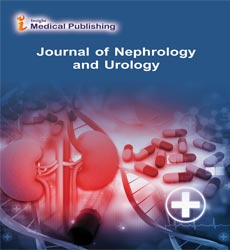Reach Us
 +447897072958
+447897072958
Co-activity of Uric Corrosive and Consistent Dimethyl Arginine as a Marker of Cardiovascular Infection in HD Patients two times/week
Visit for more related articles at Journal of Nephrology and Urology
Abstract
Background: In a study abroad, the relationship between high blood uric acid levels and cardiovascular disease in HD patients three times a week showed different results. Symmetric dimethyl arginine (SDMA) is a known marker of cardiovascular disease in a number of epidemiological studies, including in the HD patient population. In a study with a population of healthy young adults there was a relationship between high blood uric acid levels and blood SDMA level. This study need to know the relationship between blood uric acid levels and blood SDMA level in HD patients twice a week. Methods: This study was an analytical study with a cross-sectional design in 78 HD patients twice a week. This study analyzed the relationship between blood uric acid levels and confounding factors with increasing blood SDMA levels. Results: Data analysis using the Mann Whitney test found a significant difference in mean SDMA levels (P=0.027) between blood uric acid levels ≤ 8 mg/dL and >8 mg/dL. Age>65 years old (P=0.029), hypertension (P=0.005) and type of dialyzer (P=0.046) are factors that can increase SDMA levels from the results of the stratification analysis other than blood uric acid levels >8 mg/dL. Conclusion: In twice-weekly hemodialysis patients, a high blood uric acid level >8 mg/dL was associated with increased blood SDMA levels as a marker of cardiovascular disease. Age >65 years and hypertension were also associated with increased mean SDMA levels. Hemodialysis using a high flux dialyzer was associated with lower SDMA levels.
Select your language of interest to view the total content in your interested language
Open Access Journals
- Aquaculture & Veterinary Science
- Chemistry & Chemical Sciences
- Clinical Sciences
- Engineering
- General Science
- Genetics & Molecular Biology
- Health Care & Nursing
- Immunology & Microbiology
- Materials Science
- Mathematics & Physics
- Medical Sciences
- Neurology & Psychiatry
- Oncology & Cancer Science
- Pharmaceutical Sciences
